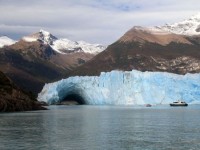By Alexandre Aguiar, MetSul Weather Center (Brazil)
2008 so far has been a very interesting year. All the months in the first half of the year ended with below normal temperature, a situation not observed since 1962. Our fall was very cold and performed like winter. June was really cold. The frost ruined 1.3 million tons of corn in the state of Parana, a damage not seen in 8 years. July has been very mild and the forecast models do not indicate any cold incursion in the next 10 days. It is quite unusual to not have very cold days in the first 15 days of July. Usually, the lowest temperatures of the year occur between July 5 and July 15th in our region. It seems the nature is compensating a very cold and early winter with mild temperatures in the peak of the climatic winter.
Regarding the Perito Moreno glacier in Argentina, which the BBC claimed had a huge ice dam on Argentina’s Perito Moreno glacier is about to break apart for the first time during the southern hemisphere winter, there is an interesting quote in the Argentinean press today: Victor Jorge Leis, operational director of the National Weather Service of Argentina, expressed doubt about global warming as the cause of the rupture of the glacier. “It is too difficult to establish a connection with the greenhouse effect because temperature has not been much above normal in the region in the last few months. Besides, temperature is just one factor in the ice behavior and wind and oceans tide should not be ignored”, he told. Other experts mentioned that the glacier tip is 400 years old, what justifies its fragility”.

The last time it ruptured in July was in 1951 (coming off a strong La Nina). There is a news report quoting one of the most important experts in the glacier that has the following headline: “The Perito Moreno rupture is not consequence of greenhouse effect: “Ricardo Villalba, director of the Argentinean Institute of Glaciology, Snow and Enviromental Sciences (Ianigla) tells Los Andes newspaper that the position of the ice and the tides can be blamed for this unusual breakup in the winter.”


